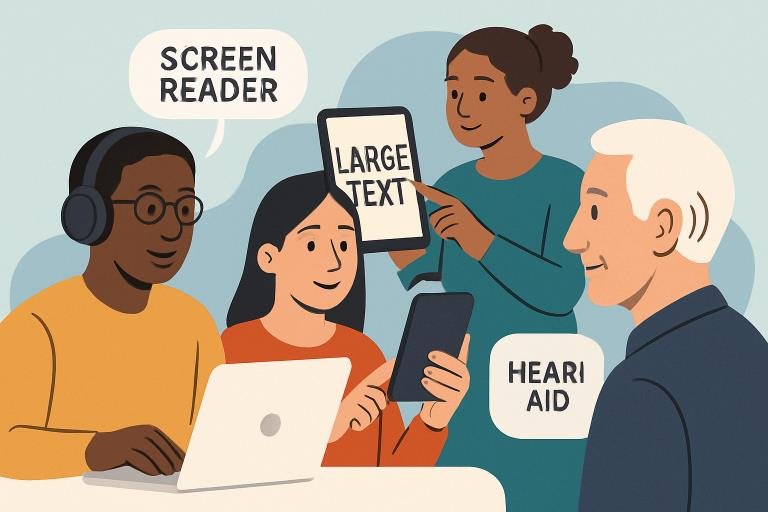Key Takeaways
- Digital accessibility is essential for inclusivity in the modern world.
- Legislation like the European Accessibility Act mandates compliance.
- Technological advancements are improving accessibility features.
- Businesses benefit from adopting accessible practices.
- Individuals can contribute to a more inclusive digital space.
As digital platforms play an increasingly central role in our daily routines, ensuring accessibility testing for mobile apps and websites becomes essential. Digital accessibility guarantees that people with disabilities can navigate, use, and benefit from digital technology just like everyone else. By making digital spaces accessible, we not only adhere to evolving legal requirements but also foster a more equitable society that values everyone’s participation.
Accessibility in the digital realm isn’t just about compliance—it’s about empathy and opportunity. Millions rely on assistive technologies and accessible content to perform essential activities like banking, shopping, working, or learning online. As we integrate smart devices, apps, and platforms into daily life, actively addressing accessibility helps break down barriers and strengthen community bonds across all age groups and backgrounds.
Innovative organizations and governments are leading the way by prioritizing inclusive design. This not only accommodates the estimated 1.3 billion people globally who experience some form of disability but also improves usability for all users. Individuals, businesses, and developers all have a role to play in building digital spaces where everyone can thrive.
Legislative mandates and new technologies are advancing accessibility, but practical steps taken by everyday users are just as vital. By understanding why accessibility matters and acting on that knowledge, we can each help build a more inclusive digital world.
Understanding Digital Accessibility
Digital accessibility encompasses the creation and maintenance of technologies that are usable by people with a range of disabilities—visual, auditory, motor, or cognitive. It involves designing websites, software, apps, and digital devices so they can be perceived, understood, navigated, and interacted with by everyone, regardless of physical or cognitive limitations.
A foundational aspect of digital accessibility is following recognized standards, such as the Web Content Accessibility Guidelines (WCAG), which establish measurable criteria for accessibility in content, structure, and functionality. Accessibility isn’t an “add-on”; it’s a strategic approach that begins at the design stage and should be maintained throughout development, testing, and updates.
Legislative Moves Towards Inclusivity
Governments around the world are taking action to promote inclusivity. Notably, the European Accessibility Act (EAA) requires digital products and services within the EU to meet strict accessibility standards by June 28, 2025. The EAA applies to mobile devices, ATMs, e-books, banking services, transportation platforms, and more, imposing significant penalties on non-compliant businesses. The United States has updated Section 508 of the Rehabilitation Act, which mandates federal agencies and contractors maintain accessible information and communications technology.
Global commitment to digital access is growing as more governments adopt or update legal frameworks, highlighting the societal importance of equality and equal opportunity. As enforcement increases, organizations risk customer loss, reputational damage, and legal penalties if they fail to prioritize accessibility. For more insights into evolving global standards, see the TechRadar’s coverage on the European Accessibility Act.
Technological Advancements in Accessibility
Modern technology is rapidly closing the accessibility gap. Artificial intelligence, voice recognition, machine learning, and natural language processing are powering solutions that adapt web content for individual needs and abilities. For example, Google’s Lookout app utilizes AI to provide verbal cues and descriptions of visual information, making everyday tasks easier for those with visual impairments.
Major software providers now integrate “Accessibility Checker” tools in their products, providing developers immediate feedback on how inclusive their designs are. Smartphones feature built-in accessibility options such as screen readers, magnifiers, and custom input devices, and leading browsers support plugins for enhanced reading or navigation. According to WIRED, AI-powered accessibility tools are reshaping digital experiences across industries, helping make information, services, and entertainment broadly available to diverse users.
Business Benefits of Digital Accessibility
For organizations, digital accessibility unlocks vast opportunities. Making products and content accessible means expanding reach to disabled consumers—a population whose global disposable income is estimated to exceed $8 trillion when factoring in family and friends. Accessibility enhances customer experience, boosts loyalty, lowers abandonment rates, and improves overall brand reputation.
Moreover, accessible digital practices often translate to better usability for everyone. Features such as transcripts, captions, larger text, and clear navigation can benefit non-native speakers, older adults, and users in challenging environments. Adopting digital accessibility isn’t just ethical—it’s good business. Many companies prioritizing inclusion see higher employee morale and retaining talented individuals with disabilities, driving innovation and productivity from within.
Practical Steps for Individuals
Individuals play a crucial role in creating a more inclusive digital world. By incorporating small changes into our digital habits and content creation, we can bridge accessibility gaps. Some practical steps include:
- Adding descriptive alt text to images, so screen readers can describe them to visually impaired users.
- Ensuring sufficient contrast between text and background colors to aid those with low vision or color blindness.
- Providing accurate captions and transcripts for video and audio materials to support users with hearing impairments or language barriers.
- Writing in plain, straightforward language to enhance understanding for those with cognitive disabilities or for whom the language isn’t native.
By making these mindful adjustments, everyone—from content creators to casual social media users—can help ensure digital inclusion. For additional everyday tips, see this resource from BBC Worklife on making digital and physical spaces more accessible.
Conclusion
Digital accessibility is fundamental to the fair and full participation of everyone in modern society. Through a combination of forward-thinking legislation, rapid technological innovation, business adoption, and individual action, we can move toward a more inclusive digital landscape. The path to true inclusion requires ongoing commitment, but with every accessible website, service, or app, we take a step closer to ensuring equal opportunity and connection for all.



